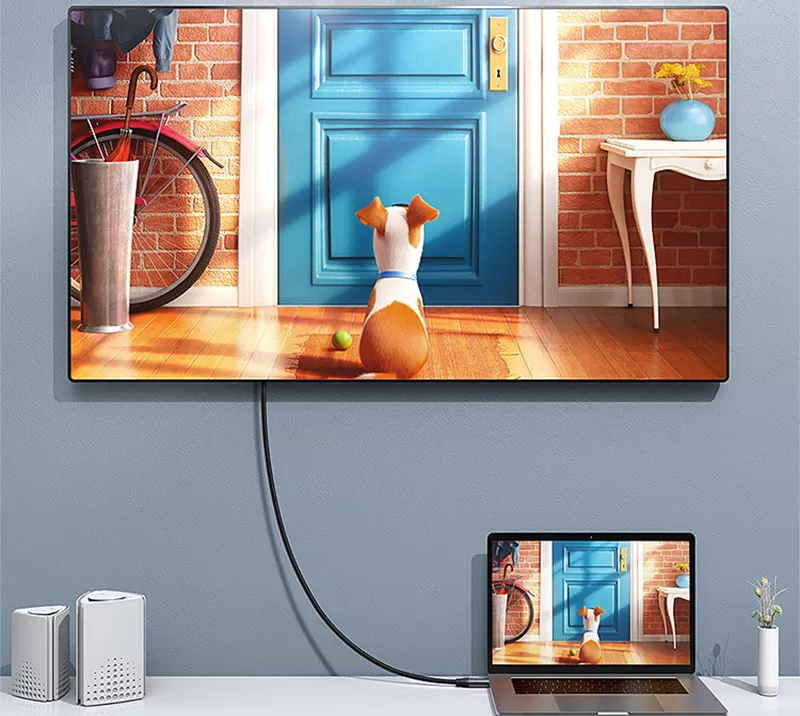Expanding knowledge about HDMI cables In today's digital era, HDMI is becoming more and more common in connections between digital entertainment, information transfer, and multimedia devices.

Expanding knowledge about HDMI cables In today's digital era, HDMI is becoming more and more common in connections between digital entertainment, information transfer, and multimedia devices.
From home entertainment to commercial applications, HDMI provides us with a transmission solution for high-definition image and video data.
Through the HDMI interface, we can connect high-definition TVs, projectors, monitors, and sound systems.
And other devices to achieve high-quality audio and video transmission and seamless connections.
Follow iSEMC’s blog and let’s learn more knowledge about HDMI.
How HDMI works?
HDMI is a fully digital video and sound transmission interface that can send uncompressed audio and video signals.
It uses digital signal transmission to send data from source devices to display devices at high rates, thereby presenting clear, high-quality images and sounds.

Differences between HDMI versions
HDMI 1.3:
supports a maximum transmission bandwidth of 10.2Gbps and supports 480P, 720P, 1080i, and 1080P video resolutions.
HDMI 1.4:
can support 4K resolution, but due to the bandwidth limit of 10.2 Gbps.
It can only display a picture of 3840×2160 pixels at a maximum refresh rate of 30Hz.
HDMI 2.0:
Expands the bandwidth to a transmission rate of 18 Gbps.
It supports 3840×2160 resolution with a 60Hz refresh rate.
In addition, HDMI 2.0 introduces support for static HDR, providing richer and more realistic image effects.

HDMI cable application scenarios
HDMI cable is the main connection equipment for transmitting high-definition video and audio signals from playback devices (such as LCD video walls, LED video walls, interactive all-in-one machines, splicers, etc.) to TVs or monitors.
It can deliver high-quality images and sound effects, and enjoy a more realistic and clear image experience. The quality of the HDMI cable affects the display effect of the LCD splicing screen.
The following is the connection methods of different splicing screens:

Single screen display:
LCD splicing screens, the large advertisements we often see on the street, are composed of many screens.
For a single screen, we only need to connect the HDMI interface behind the LCD splicing screen to the computer.

Multi-screen display:
For example, how should we connect 12 LCD splicing screens to the computer?
Each small piece of the LCD splicing screen is equipped with a splicing processor, and multiple splicing processors are connected.
When a project, that is, the entire splicing screen is completed, it is equivalent to a display device. We only need to transmit one signal Just plug in.
In actual cases, many industries require multiple computers to be connected to the LCD splicing wall.
At this time, we must be equipped with a matrix.
The matrix interface is more abundant. We only need to find the corresponding interface.
HDMI Extension Cable
If you feel that the HDMI cable is not long enough, but using multiple routers would be prohibitively expensive, the good news is that you can use extension cables to meet your needs.

70MHDbase extender
Support POC (Power Over Cable) function;
Support the use of a UTP network cable (Cat5e/6) to achieve long-distance transmission;
Network cable (cat6)
70 meters: 1080P@60Hz/36bit; 3D 1080P@30Hz/36bit;
40 meters: 1080P@60Hz/48bit; 1080P@120Hz/24bit; 3D 1080P@60Hz/36bit; 4K x 2K@30Hz/24bit;
Support HDMI 1.4 and HDCP 2.2, display resolution up to 4K x 2K@30Hz;
Support Full HD: 1080p@60Hz@48 bit/pixels; 1080p@120Hz@24 bit/pixels, 3D 1080P60Hz and 4K x 2K@30Hz@24bit;
Support two-way broadband infrared control signal transparent transmission;
Support two-way RS-232 control signal transparent transmission;
100M HDBaseT Extender
Support HDMI 1.4 standard and HDCP protection protocol;
Support POE(Power Over Ethernet);
Single network cable (CAT-6) can transmit 1080p/60Hz signal up to 100 meters distance;
Transmission distance: (based on standard CAT6 cable)
100 meters: 1080P @60Hz36bit; 3D1080P@24Hz36bit;
70 meters: 1080P@60Hz@48bit; 1080P@120Hz@24bit;
3D1080P@60Hz@36bit; 4K x 2K@30Hz@24bit;
Support two-way transmission of infrared remote control signals;
Support RS232 control two-way transmission;
Support 100M (100Mbps) Ethernet transmission;
UTP cable wiring method conforms to EIA/TIA-568B standard
HDMI 150M HDBaseT Extender
Support HDMI 1.4, HDCP 1.4, and DVI compliant;
The video resolution reaches 1920*1200 @60Hz (YUV4:4:4);
Supports high bit rate (HBR) audio via HDMI;
Use CAT6 network cable to reach a transmission distance of 150 meters;
Support POC (Power over Cable) function;
Support the transmission of two-way infrared control signals;
Support transmission of bidirectional RS-232 signal.
iSEMC has three HDbase Extender with different distances, which can deliver high-quality images and sound effects to the splicing screen, allowing you to enjoy more realistic and clear images.

Regarding long HDMI cables:
The longer the cable, the higher the chance of poor quality, lagging picture or sound, poor graphics, poor refresh rate, and low brightness, and the signal will take longer to travel and become weaker.
One potential problem with long cables is that if there are kinks or twists anywhere in the wires, it will affect the quality of the signal.
iSEMC has an AV OVER IP solution, which perfectly replaces the shortcomings of long-distance transportation, especially in some different rooms, and avoids the problems encountered by physical wiring.
Final thoughts
The use of HDMI cables not only transmits high-quality images and sound effects but also brings us a more realistic and clear image experience.
It plays an important role in home entertainment, business presentations, and other industries, promoting the development of video digitization and high-definition.



